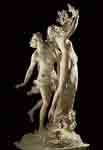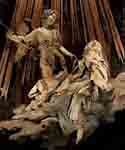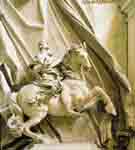 Gianlorenzo Bernini was born in Naples in 1598. He trained with his father Pietro Bernini, a famous sculptor at the time. The artist’s first works were made with his father, so the touch of both can be seen in some works. There are three works known to date with certainty to the artist’s early years: the Capra Amaltea, finished in 1615, inspired by the Hellenism of the Alexandrine period; Priapus and Flora. Other works which were made by father and son are: the Child with the Dragon, the Fountain with the satyr and the Panther, in the museum of Berlin; the Group of Bacchus in the Metropolitan Museum of New York. In the Four Seasons in Villa Aldobrandini the still life elements were painted by Gianlorenzo. In about 1618 the artist was greatly interested in the study of expressions and emotional responses. The results of this interest are Martyrdom of St Lawrence, St Sebastian, Child bitten by a fish and the Blessed Soul and the Damned Soul. The Blessed Soul portrays a girl in ecstasy whereas the Damned Soul (probably a self-portrait) resembles Medusa’s Head (painted by Caravaggio).
Gianlorenzo Bernini was born in Naples in 1598. He trained with his father Pietro Bernini, a famous sculptor at the time. The artist’s first works were made with his father, so the touch of both can be seen in some works. There are three works known to date with certainty to the artist’s early years: the Capra Amaltea, finished in 1615, inspired by the Hellenism of the Alexandrine period; Priapus and Flora. Other works which were made by father and son are: the Child with the Dragon, the Fountain with the satyr and the Panther, in the museum of Berlin; the Group of Bacchus in the Metropolitan Museum of New York. In the Four Seasons in Villa Aldobrandini the still life elements were painted by Gianlorenzo. In about 1618 the artist was greatly interested in the study of expressions and emotional responses. The results of this interest are Martyrdom of St Lawrence, St Sebastian, Child bitten by a fish and the Blessed Soul and the Damned Soul. The Blessed Soul portrays a girl in ecstasy whereas the Damned Soul (probably a self-portrait) resembles Medusa’s Head (painted by Caravaggio).
The statue of Anchises, Eneas and his son Ascanius is the first of a number of important works in the Borghese Gallery: David, the Rape of Proserpina, Apollo and Daphne. David is about to throw a stone: the expression on his face shows the effort and the tension of the act. In Apollo and Daphne the nymph is changing into a tree. The observer perceives movement in the space round the figures, in the folds of their clothing and in the leaves which seem to be blowing in the wind.
 At the same time he carved the bust of Camilla Barbadori, painted the portraits of Carlo Antonio dal Pozzo, Paul V, Gregory XV and the De Fox Montoya (1621-1622).
At the same time he carved the bust of Camilla Barbadori, painted the portraits of Carlo Antonio dal Pozzo, Paul V, Gregory XV and the De Fox Montoya (1621-1622).
In 1623 he received a commission for the canopy of St Peter by Pope Urban VIII; he worked on it between 1624 and 1633. TheCanopy over Peter’s grave is supported by four twisting columns, resembling the style of the II century columns, given to the basilica by Constantine. Bernini used them as supports of the central aedicoli of the Relic Balconies.
The Relic Balconies were made immediately after the Canopy (between 1633 and 1641) and were made to exhibit – in certain occasions – the relics inside: the Lance of St Longino, the head of St Andrew, the Holy Face and part of the Cross.
Between 1628 and 1647 he executed the Tomb of Urban VIII in St Peter’s; at the same time he carved the busts of Scipione Borghese and of Costanza Piccolomini Bonarelli.
The Fontana della Barcaccia, in piazza di Spagna, and the Triton’s Fountain in piazza Barberini in Rome were commissioned by  Urban VIII. In 1644 the artist carved the Four River Fountain in Piazza Navona in Rome for Pope Innocent X Pamphilj. Shortly after he finished the Ecstasy of St Theresa in the Cornaro chapel in Santa Maria della Vittoria. The entire chapel is built with special arrangements to make it spectacular: the relatives of the deceased look at the Ecstasy on the altar form the side balconies. Other works dating from this period are: the Monument of Suor Maria Raggi,the Truth (Borghese Gallery) and the portrait busts of Innocent X in the Galleria Doria Pamphilj and the bust of Francesco I d'Este in the Museo Estense of Modena.
Urban VIII. In 1644 the artist carved the Four River Fountain in Piazza Navona in Rome for Pope Innocent X Pamphilj. Shortly after he finished the Ecstasy of St Theresa in the Cornaro chapel in Santa Maria della Vittoria. The entire chapel is built with special arrangements to make it spectacular: the relatives of the deceased look at the Ecstasy on the altar form the side balconies. Other works dating from this period are: the Monument of Suor Maria Raggi,the Truth (Borghese Gallery) and the portrait busts of Innocent X in the Galleria Doria Pamphilj and the bust of Francesco I d'Este in the Museo Estense of Modena.
During the pontificate of Alexander VII Chigi, Bernini worked on the side of the apse in St Peter. There is a false opening between the enormous pilasters, where clouds, sunrays and angels can be seen. TheDove of the Holy Ghost is in the centre and in front of it St Peter’s Chair is lifted by the four Fathers of the Church. Bernini left his assistants to finish the work on the Chair, as in 1665 he went to France to carve the bust of King Louis XIV.
Upon his return to Italy he worked on the Monument at the centre of the Minerva Square and in the chapel of Forgiveness in the Duomo of Siena, with the statues of St Jerome and Magdalene.
 In 1667 Pope Alexander VII Chigi was succeeded by Clement IX Rospigliosi, who employed the artist to finish and decorate the bridge in front of Castel Sant'Angelo. Bernini worked on two of the ten angels planned for the balustrade; they were considered too beautiful to be left out in the open and were moved to the church of Sant'Andreadelle Fratte.
In 1667 Pope Alexander VII Chigi was succeeded by Clement IX Rospigliosi, who employed the artist to finish and decorate the bridge in front of Castel Sant'Angelo. Bernini worked on two of the ten angels planned for the balustrade; they were considered too beautiful to be left out in the open and were moved to the church of Sant'Andreadelle Fratte.
In 1669 Pope Clement IX was succeeded by ClementX Altieri. During his pontificate the Scala Regia (Royal Staircase) was inaugurated; at the foot of the staircase is a statue of Constantine, in the moment he had the vision of the Cross: he is marvelled and surprised and his feelings are mirrored and expanded by the position of the horse he is riding. In the background fabric blown by the wind gives spatial depth to the whole picture. Other works represent inner feelings and passion: examples are the Monument to the Beata Ludovica Albertoni in St Francesco a Ripa, the portrait of Fonseca and the Angels in the Chapel of the Sacrament in St Peter.
The artist’s last work of sculpture was the Saviour (Chrysler Museum, Norfolk, Virginia). He died during the pontificate of Innocent XI Odescalchi, in 1680.